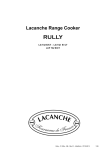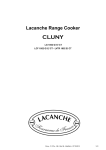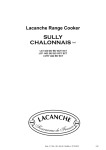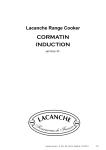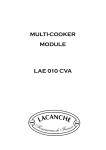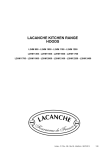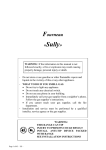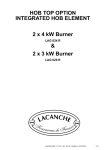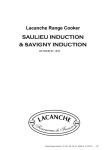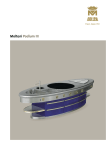Download SIMMER PLATE (ON TRADITIONAL HOB)
Transcript
SIMMER PLATE (ON TRADITIONAL HOB) Plaque coup de feu - GB - Rév 00 - Modifié le : 20/01/2014 1/3 SIMMER PLATE (ON TRADITIONAL HOB) The simmer plate is an enamelled cast iron plate heated by a high-power gas burner. It can be used as a work surface and several saucepans can be placed on it at the same time. Using the traditional hob (simmer plate) is ideal for cooking larger pots (jam, pans, fish & ham nettles) or for using a matter of pans at once over the large cooking area. The center ring is the hot part and the heat differencies from here across the simmer plate : it is therefore cooker towards the edges, where you might leave a pot simmering / holding. By removing the central round disc, the burner below can be used as a conventional open burner. The Lacanche wok ring sits in place of the central disc, for use with a wok for stir or frying. Description : The heating plate is made entirely of enamelled cast iron. It consists of two parts, the main part rests directly on the cooking surface and the other removable plug part is located in the middle of the plate. ► ► ► ► ► ► CAUTION: Temperature may exceed 300 °C. Warn users of the potential risks. Designation Diameter of the burner cap Power Ultra fast Ø 107 mm 5 kW Intensive Ø 90 mm 4 kW Fast Ø 72 mm 3 kW Semi fast Ø 55 mm 1,5 kW Use : Remove the centre from the simmer plate by means of the lever rod provided. Simultaneously press down onto and turn the burner dial anti-clockwise to setting . Press the ignition button while maintaining pressure on burner dial for about 20 seconds to initialise safety A reduced flowrate position identified by the mark produces the preset minimum burner power (low flame). Replace the centre piece. To turn off, turn the control knob clockwise to the « » position. The control knob returns to its initial position, the latching mechanism operates and the gas safety cut-out is activated several seconds after the burner goes out. Do not use water to clean the simmer plate when it is hot. This can damage it. USER’S MANUAL Plaque coup de feu - GB - Rév 00 - Modifié le : 20/01/2014 2/3 CLEANING AND MAINTENANCE Before any cleaning work, close the gas supply and/or isolate from the mains electricities supply Do not use a steam cleaner to clean the range. Gas hobs : The burners are made in two parts in order to facilitate cleaning. Clean them separately,. → Burner cap : Burner caps are made of solid brass. Use a special brass-cleaning product (e.g. MIROR® or BRASSO®) and a soft cloth. If the product runs onto the enamel do not rub (these products generally contain abrasives). Rinse immediately with clean water without rubbing. If the caps are very dirty polish them with very fine sand paper and then rub them with a copper cleaner. → Burner body : The aluminium bodies of the burners become stained with use. They should be cleaned regularly with a scouring pad (Scotch Brite®). After removing the pan supports and burners, the cooking surface can be cleaned easily and thoroughly by simply using a sponge. Do not use scouring pads or abrasive products such as oven cleaners and stain removers. When cleaning, be careful not to splash liquid into the openings of the burners. Traditional Hob (Simmer Plate) : Do not use water to clean the simmer plate when it is hot. This can damage it. Immediately remove any spillages to make cleaning easier. Use a sponge moistened with soapy water or scouring powder. CAUTION Use NON chlorinated cleaners to clean this unit. Carefully read the precautions and recommendations for applying the products you use to clean and maintain the range. Follow the instructions for use. USER’S MANUAL Plaque coup de feu - GB - Rév 00 - Modifié le : 20/01/2014 3/3



